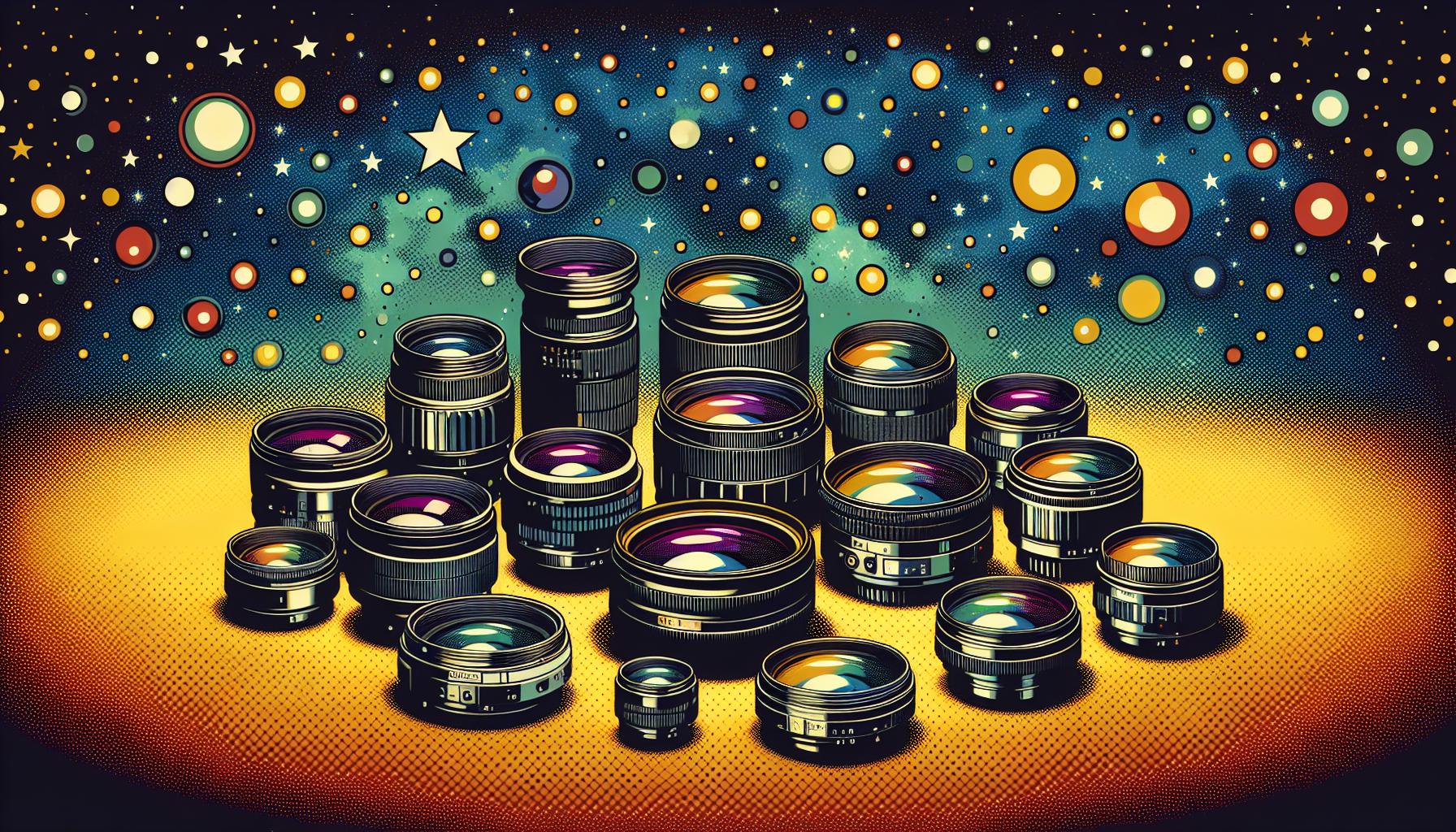This site contains affiliate links to products. I may receive a commission for purchases made through these links.
Astrophotography’s allure is undeniable. Who wouldn’t want to capture the majestic cosmos in all its glory? But it’s not as simple as pointing your camera skyward and clicking the shutter. One key factor to consider is the focal length of your lens.
Focal length can make or break your astrophotography. It dictates how much of the night sky you’ll be able to frame in your shot. It’s a delicate balance—too short, and you might not capture the details of celestial bodies; too long, and you risk cutting out interesting features.
So, what’s the sweet spot? Let’s delve into the world of focal lengths and find the perfect match for your astrophotography needs.
Importance of Focal Length in Astrophotography
When diving into the captivating world of astrophotography, focal length plays an integral role in shaping your night sky imagery. It’s the determining factor in capturing not just a shot, but the shot. Simply put, focal length influences how much of the starry heavens your camera will see.
Using a short focal length lens allows for wide-field views. You’ll get breath-taking panoramas of the sky filled with galaxies, nebulae, and constellations. It’s an ideal setup for large celestial objects or for when you want to capture a broad swathe of the night sky.
However, swap to a long focal length lens and you’re peering deeper into the cosmos. Thousands of light-years away, to be precise. These lenses are more suitable for capturing the fine details of individual planets, stars, and other celestial bodies. A high-power telescope will dive even deeper, providing crisp images of far-off galaxies.
But beware, too long a focal length and you might miss out on other fascinating aspects of the night sky. That shooting star, hint of the Milky Way, or that barely perceivable asteroid could just be out of frame.
Finding the perfect balance and mix of lenses in your astrophotography kit can help deliver unforgettable images. It’s about understanding your photographic goals and the scenario you’re in. Ask yourself, are you looking to snap wide, dramatic field views, or are you more interested in the minute details of specific celestial objects?
Remember, unmanned voyages into space have gifted us images beyond our imagination but the same universe is accessible from your backyard. Equipped with the knowledge of how focal length influences your astrophotography, you are set on the right path.
Let’s delve further into the practical aspects of deciding the optimal focal length for your astrophotography needs.
Short Focal Lengths: Pros and Cons
When it comes to astrophotography, short focal lengths provide unique advantages. With a lens that has a short focal length, you’re able to capture wide field views of the night sky. This makes it possible to take breathtaking panoramas filled with a multitude of celestial bodies, from galaxies and nebulae to the full splendor of constellations.
Using such a lens, I can get large chunks of the sky into a single frame, allowing me to provide viewers a sense of scale and grandeur impossible with long focal lengths. Short focal lengths are spectacular for capturing larger deep-sky objects like the Orion Nebula or the Andromeda Galaxy.
However, there’s a flip side to using short focal lengths for astrophotography. While they’re excellent for taking in sweeping views of the cosmos, they’re not so great if you want to capture the fine details of individual planets, stars, or moons. The Moon, for instance, can look like a small, almost insignificant speck in the frame. This lack of magnification is a tradeoff you make when choosing a wide field of view.
Also, fast, wide-angle lenses often have issues with distortion and vignetting at the corners, which may detract from the quality of your cosmic vistas. This means the lens suffers from a drop in brightness or sharpness toward the edges.
So, the choice of using short focal lengths for astrophotography depends largely on your goals. If your aim is to provide expansive views of the night sky with a myriad of celestial bodies, a short focal length lens may serve you well. But if you’re interested in zooming in on individual planets or stars, a long focal length lens might be more suited to your needs. Balance it out and consider wisely before making a selection.
Long Focal Lengths: Pros and Cons
After discussing wide angles and short focal lengths, let’s shift our focus to long focal lengths, which are crucial to astrophotographers aspiring to capture the intricate details of celestial bodies. I’ll emphasize that long focal lengths aren’t just for detail seekers; they have a variety of advantages, but also a few drawbacks.
Firstly, let’s shed some light on the perks. Using a long focal length lens can provide much-needed magnification. It enables us to capture details of distant planets, moons, and star clusters that are often missed by wider-angle lenses. For a sense of scale, lenses with a focal length of 200mm and beyond fall into this category, offering a narrow field of view and a high degree of magnification.
However, there’s no such thing as a free lunch. Where there are strengths, there are bound to be challenges. One of the major downsides to using a long focal lengths is their susceptibility to camera shake. Even with the best tripod and careful handling, little vibrations can result in blurred images. You’ll need to ensure you have a good stabilization system in place.
Another hurdle is the reduced amount of light reaching the camera’s sensor. Long focal length lenses often have a smaller aperture, which means less light entering the camera. This can limit the camera’s ability to capture low-light objects, and may require longer exposure times.
Lastly, there’s the considerable weight and size. Long focal length lenses are typically larger and heavier, making them more difficult to carry around, especially if you’re trekking to a remote location for a photoshoot.
Despite these challenges, many astrophotographers appreciate the high level of detail these lenses offer. The decision to use a long focal length often hinges on the photographer’s individual goals, the kind of celestial objects they’re aiming to capture, and the environment in which they’re shooting. As we proceed, we’ll delve into how one can adapt and overcome the limitations to fully reap the benefits of long focal lengths in astrophotography.
Finding the Sweet Spot: Ideal Focal Length for Astrophotography
I’ve explored various aspects of focal length in astrophotography and with my experience, it’s evident that fine-tuning will give you the ideal focal length for your astrophotography ventures. But making the choice isn’t as straightforward as it may sound. The perfect focal length greatly depends on the celestial objects you aim to capture.
For instance, wide-angle lenses, with focal lengths lower than 35mm, excel at capturing large swaths of the night sky, including star trails and the Milky Way. You’d want to carry along a wide-angle lens on a clear, moonless night to capture majestic astro-landscapes.
On the other hand, long focal lengths — that is, anything above 200mm — are your go-to for specific celestial bodies. They’re fantastic at capturing details of planets and stars, providing impressive magnification at the expense of some hurdles. If you’re into the intricacies of the universe, these are your telescopes camouflaged as lenses.
However, if you’re seeking versatility, I’d recommend anything between 50mm and 200mm. They offer a balance between object size and the field of view. They excel in capturing larger celestial objects like the moon, helping bring out its detail without swallowing your entire frame.
This does not establish any concrete rule. You’re always free to experiment and dodge the guidelines. In the end, it’s all about the celestial objects you yearn for and the story you wish to narrate through your lens. And remember, while the lens is crucial, your skills as a photographer play an equally important part in clicking that perfect shot.
Practical Tips for Using Different Focal Lengths
When it comes to utilising varied focal lengths in astrophotography, it’s vital to comprehend not only the benefits but also the distinct challenges they present.
Embrace Wide-Angle Lenses
Wide-angle lenses, with focal lengths fewer than 35mm, enable you to encompass larger sections of the night sky. They’re brilliant for photographing expansive starfields, Milky Way landscapes, and meteor showers. However, it’s key to remember to use longer exposures in order to effectively capture more light. This potential downside can be managed well with tracking mounts.
Understanding Mid-Range Focal Lengths
Mid-range focal lengths, situated between 50mm and 200mm, offer a balance between object size and field of view. This makes these lenses flexible for capturing larger celestial objects like the Moon, Andromeda, or Orion’s Belt. They present an attractive midpoint for those striving for a blend of detailed subjects and context-providing vistas.
Long Focal Lengths for Detailed Observation
Next, we’ve got long focal lengths that measure upwards of 200mm. These are perfect for shooting specifics, such as details on the Moon’s surface or Jupiter’s moons. While it may take more time to find and track objects, the detail achieved can be terrifically rewarding.
Choose the Suitable Tracking Mount
One aspect that can’t be ignored is the need for a stable tracking mount. The longer the focal length, the more necessary a reliable tracking mount becomes. This directly impacts the clarity plus level of detail in your images.
Conclusion
So, there’s no one-size-fits-all answer to the best focal length for astrophotography. It’s all about what you’re aiming to capture. Wide-angle lenses below 35mm are great for sweeping views of the night sky. A mid-range focal length between 50mm and 200mm offers versatility, while long focal lengths above 200mm deliver stunning detail of specific celestial bodies. Remember though, a solid tracking mount is a must-have when using longer focal lengths.
But above all, it’s your skills as a photographer that’ll truly make the difference. So, keep shooting, keep learning and keep exploring the night sky. Your perfect shot is out there, waiting for you to capture it.
FAQ
What is the significance of focal length in astrophotography?
Focal length is crucial in astrophotography as it determines the field of view and the size of the celestial objects you’re capturing. Different focal lengths serve varying purposes, depending your particular photography goal.
Why are wide-angle lenses recommended for astrophotography?
Wide-angle lenses have a focal length below 35mm, making them great for capturing large sections of the night sky. These lenses can capture beautiful wide-field views of the stars, the Milky Way, and constellations.
What advantage does a mid-range focal length provide?
A mid-range focal length, typically between 50mm and 200mm offers a balance between object size and field of view. This makes them versatile for photographing larger celestial objects such as the moon or planets.
When should I use a long focal length?
If you desire to capture details of specific celestial bodies, a long focal length above 200mm is ideal. However, remember to use a stable tracking mount to ensure clarity and detail.
How important are the skills of the photographer in astrophotography?
While the lens plays an integral role in producing a quality image, the skills of the photographer are equally important. Understanding how to adjust your settings for the conditions and your desired outcomes, as well as how to use equipment properly, can make the difference between a successful shot and a failure.



